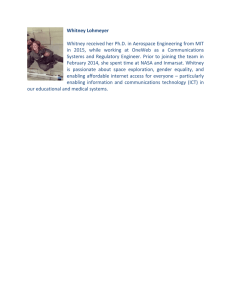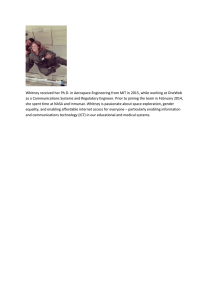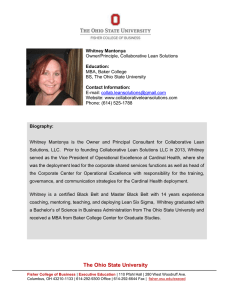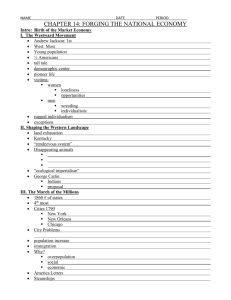Document 13609600
advertisement
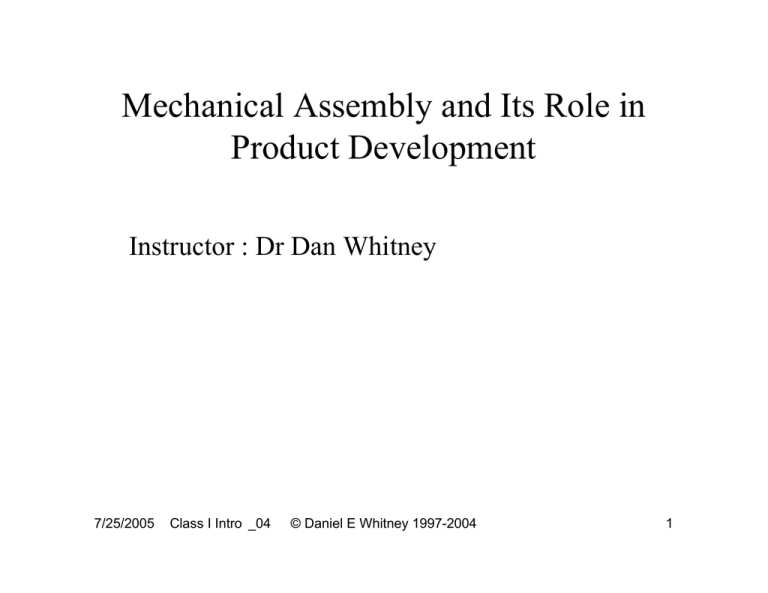
Mechanical Assembly and Its Role in Product Development Instructor : Dr Dan Whitney 7/25/2005 Class I Intro _04 © Daniel E Whitney 1997-2004 1 Goals of this Course • Understand a systematic approach to analyzing assembly problems • Appreciate the many ways assembly influences product development and manufacturing • See a complete approach that includes technology, systems engineering, and economic analysis • Get a feeling for what is technologically feasible • Practice the systematic process on a semester-long group project of your own 7/25/2005 Class I Intro _04 © Daniel E Whitney 1997-2004 2 About Me • Mechanical engineering and history at MIT • Taught at MIT ‘68 - ‘74 • 19 years at Draper Lab doing research and consulting in robotics and assembly • Applied system engineering techniques to product design for assembly and assembly process design • Came to understand fuzzy boundary between management and engineering • Returned to MIT in 1993 • Teach Sloan-Eng Product Development Class to SDM • Also interested in complex systems 7/25/2005 Class I Intro _04 © Daniel E Whitney 1997-2004 3 Assembly in the Context of Product Development Org, MOT, Strategy Technology And Market Customer Needs Requirements One product? Product Family? Customization ? Reuse? 65% outsourced Flow of “influence” of decisions This course Functions Architecture Assemblies Parts Evolution of Market and Technology 7/25/2005 Direct info flow in product dev. Product design and development Class I Intro _04 Fabrication & Inspection Assembly and Test Follow-on product reuses arch, some assemblies, some parts © Daniel E Whitney 1997-2004 Distribution Use Upgrade Repair Disassembly Reuse Recycle 4 Assemblies are Systems • • • • Assembly is inherently integrative Assemblies can be designed top-down Decomposition and interface management are key Assemblies exhibit non-colocation of cause and effect • Assemblies also violate a hidden assumption: – big causes have big effects while small causes have small effects 7/25/2005 Class I Intro _04 © Daniel E Whitney 1997-2004 5 Assemblies are Complex • Hundreds, thousands, tens of thousands of parts • Divided into manageable subassemblies which are further divided, so that most have 10 - 20 parts • Many versions of the same product based on different subassemblies or parts: – many opportunities for customization – many chances for error • “I’m continually amazed that the thing works at the end of the line.” 7/25/2005 Class I Intro _04 © Daniel E Whitney 1997-2004 6 Chain of Delivery of Quality Shows clearly who delivers what and how long the chains of delivery are Image removed for copyright reasons. Source: Figure 1-8 in [Whitney 2004] Whitney, D. E. Mechanical Assemblies: Their Design, Manufacture, and Role in Product Development . New York, NY: Oxford University Press, 2004. ISBN: 0195157826. PART COUNT: 9 PART SOURCES: 7 TOOL COUNT: 5 TOOL SOURCES: 4 CHECK FIXTURE COUNT: 2 CHECK FIXTURE SOURCES: 2 DISPERSAL INDEX: 81% “Oh, we buy the radiator support” 7/25/2005 Class I Intro _04 © Daniel E Whitney 1997-2004 7 Course Mechanics • Class lectures and discussions Mon & Wed 1:00 -2:30 • Textbook at the Coop: “Mechanical Assemblies: Their Design, Manufacture, and Role in Product Development”, Oxford University Press, 2004 • Reading and homework assignments on MIT Server • A group project to be done in phases during the term • Homework – 6 project reports – 4 problem sets • A mid-term and a final project presentation • No quizzes or final exam • Grade formula: 1/3 on homework, 1/3 on project reports, 1/3 on midterm and final presentation 7/25/2005 Class I Intro _04 © Daniel E Whitney 1997-2004 8 Project Guidelines • Buy a small assembled product costing no more than ~$35 and having 10 to 20 parts –– Be sure you can take it apart and put it back together together –– Save the packaging and instructions – SDM students can use a product from work • You will analyze it in detail technically and economically and design an assembly line • Wednesday Sept 15 hand in a description of what you bought and names/e-mails of team members • Examples: hand-held power tools, small clocks and timers, Luxo lamps, small home appliances, toys • Schedule a time to show it to me for an hour ASAP • Hand in Request for Payment to get reimbursed. 7/25/2005 Class I Intro _04 © Daniel E Whitney 1997-2004 10 Electric Drill Image removed for copyright reasons. Source: Figure 13-1 in [Whitney 2004] Whitney, D. E. Mechanical Assemblies: Their Design, Manufacture, and Role in Product Development. New York, NY: Oxford University Press, 2004. ISBN: 0195157826. 7/25/2005 Class I Intro _04 © Daniel E Whitney 1997-2004 11 Toy Image removed for copyright reasons. Source: Figure 13-10 in [Whitney 2004] Whitney, D. E. Mechanical Assemblies: Their Design, Manufacture, and Role in Product Development. New York, NY: Oxford University Press, 2004. ISBN: 0195157826. 7/25/2005 Class I Intro _04 © Daniel E Whitney 1997-2004 12 Staple Gun Image removed for copyright reasons. Source: Figure 15-30 in [Whitney 2004] Whitney, D. E. Mechanical Assemblies: Their Design, Manufacture, and Role in Product Development. New York, NY: Oxford University Press, 2004. ISBN: 0195157826. 7/25/2005 Class I Intro _04 © Daniel E Whitney 1997-2004 13 Juicer Images removed for copyright reasons. Source: Figure 3-32 in [Whitney 2004] Whitney, D. E. Mechanical Assemblies: Their Design, Manufacture, and Role in Product Development. New York, NY: Oxford University Press, 2004. ISBN: 0195157826. 7/25/2005 Class I Intro _04 © Daniel E Whitney 1997-2004 14 More Mechanics • Sign up on MIT Server. • Join the group called 2.875 Mechanical Assembly…and go to “documents” – One page word doc syllabus under “Public Files” – Class schedule, assignments, and project deliverables excel file called detailed_schedule under “Detailed Syllabus” – Class slides pdf files under “Lecture Notes” • All class presentations, homework assignments, and other info will be posted there • Right now, download the word doc under Public Files and the excel file under Detailed Syllabus – Look at Excel sheets 1, 2, and 3 for detailed outline, reading assignments and project deliverables 7/25/2005 Class I Intro _04 © Daniel E Whitney 1997-2004 15 Class Schedule -Typical Tuesday Sept 3 Registration Day Wednesday Sept 4 Class 1 Introduction, Logistics, Context, History Monday Sept 9 Class 2 Assembly in the Small - Step-by-step process -Assembly Motions and Forces Wednesday Sept 11 Class 3 Assembly in the Small -Rigid part mating theory & RCC Monday Sept 16 Class 4 Mathematical models of assemblies, Feature-based modeling of assemblies Wednesday Sept 18 Class 5 Constraint in Assembly-1 Monday Sept 23 Holiday No Class Wednesday Sept 25 Class 6 Constraint in Assembly-2 Monday Sept 30 Class 7 Key Characteristics Wednesday Oct 2 Class 8 Variation buildup in assemblies-1 Monday Oct 7 Class 9 Variation buildup in assemblies-2 Wednesday Oct 9 Class 10 Assembly sequence analysis, algorithms, and software Monday Oct 14 Holiday No Class Wednesday Oct 16 Class 11 The Datum Flow Chain-1 Monday Oct 21 Class 12 The Datum Flow Chain-2 Wednesday Oct 23 more DFC 7/25/2005 Class I Intro _04 © Daniel E Whitney 1997-2004 Assembly in the small Assembly in the large 17 Class Schedule - Typical Monday Oct 28 Class 13 Assembly in the Large - basic issues, economics, step-by-step process Wednesday Oct 30 Class 14 Product Architecture, flexibility Monday Nov 4 Class 15 Design for Assembly – Theory, Examples and video Wednesday Nov 6 Class 16 AITL System Design Issues: Kinds of assembly lines and equipment, production volume, cycle times Class 18 Monday Nov 11 Holiday No Class Wednesday Nov 13 Class 17 Midterm presentation of student projects covering first three reports Monday Nov 18 Class 19 Assembly in the large: Workstation design issues Wednesday Nov 20 Class 20 Assembly System Design Software Monday Nov 25 Class 21 Discrete Event Simulation Wednesday Nov 27 Class 22 Economic analysis of assembly systems Monday Dec 2 Class 23 Outsourcing, & supply chain management Wednesday Dec 4 Class 24 767 Wing Case Study Monday Dec 9 Class 25 Student project presentations 7/25/2005 Class I Intro _04 © Daniel E Whitney 1997-2004 18 Wednesday Sept 18 Problem set on rigid part mating due Wednesday Sept 25 First project report due: Completely describe the product Each report generates info for later reports Wednesday Oct 2 Problem set on 4x4 matrices due Wednesday Oct 16 Problem set on tolerances and constraint due Wednesday Oct 23 Problem set on DFCs due Wednesday Oct 30 Second project report due: DFC analysis of your product Wednesday Nov 13 Third project report due: Choreograph each assembly step & DFA Wednesday Nov 20 Fourth project report due: Design a workstation Wednesday Nov 27 Fifth project report due: Create a floor layout 7/25/2005 Wednesday Dec 4 Sixth project report due: Economic analysis of this layout and Discrete event simulation Class I Intro� _04 © Daniel E Whitney 1997-2004 Project Reports and Homework Wednesday Sept 11 Student project descriptions due 19 Why is Assembly Important? • Assembly is inherently integrative – brings parts together – brings people, departments, companies together – can be the glue for concurrent engineering • Assembly is where the product comes to life – there aren’t many one-part products • Assembly is where quality is “delivered” – quality is delivered by “chains” of parts, not by any single most important part • A paradox: assembly is not a big cost element 7/25/2005 Class I Intro _04 © Daniel E Whitney 1997-2004 20 Make-Buy Complexity: Product Development on a Web A PRODUCT DESIGN STARTS OUT FROM ONE POINT ASSEMBLER/ DESIGNER ASSEM S DESIGN DE S IGN S TOOLING SUPPLIER PARTS SUPPLIER HU N 7/25/2005 DRE DS OR THOU S AN Class I Intro _04 ASSEMBLY SUPPLIER OLS BLY TO PARTS SUPPLIER ASSEMBLY SUPPLIER NS SP IF C E O PARTS TOOLING SUPPLIER O TI A IC ASS DE EM SIG BLI ES NS NS SP EC IF IC AT IO I BR A F TI CA NT LS OO DE NS PA RT S FINALASSEMBLY ASSEMBLY IS THE FINAL "MOMENT “MOMENT OF OF TRUTH" TRUTH” FOR THE ENTIRE PROCESS G SI IT GETS DISPERSED OVER THE SUPPLY WEB PARTS SUPPLIER ARS DS OF MILES AND THREE TO TEN YE © Daniel E Whitney 1997-2004 21 Assembly Links Unit Manufacturing Processes to Business Processes Business Context Production volume Model mix, variety, customizing Upgrade, update Reuse, carryover Outsourcing System Level Subassemblies Assembly sequences Assembly quality Line automation Line layout People involvement Technical Details Individual part joining Individual part quality Part prep, logistics, feeding Manual vs automatic Speed, cost 7/25/2005 Class I Intro _04 © Daniel E Whitney 1997-2004 23 Example of This Link Denso makes many kinds of panel meters for Toyota. Toyota orders different ones in different amounts every day. Denso designed an “assembly family” of meters and can make any quantity of any kind at any time by selecting the right parts. Assembly interfaces were standardized for all parts. The result is ‘assembly-driven manufacturing.” Images removed for copyright reasons. Source: Figure 1-7 in [Whitney 2004] Whitney, D. E. Mechanical Assemblies: Their Design, Manufacture, and Role in Product Development. New York, NY: Oxford University Press, 2004. ISBN: 0195157826. 7/25/2005 Class I Intro _04 © Daniel E Whitney 1997-2004 24 History and Present Status • • • • • • Traditional unit processes studied for 150+ years Assembly studied perhaps 40 years Most assembly is manual Most assembly process design is manual Surge in interest in robot assembly in the 70s Interest in “appropriate technology” today 7/25/2005 Class I Intro _04 © Daniel E Whitney 1997-2004 25 Need for a Systems Approach • “We design parts, we don’t design assemblies” • “We spent all day identifying the reasons why certain features on certain parts relate to features on other parts” • “Tolerances are those little numbers that you have to put on the drawing before the boss will sign off” • “You can’t have both cosmetic quality and functional quality” (car doors) 7/25/2005 Class I Intro _04 © Daniel E Whitney 1997-2004 26 Outline of Requirements-Driven Step- by-Step Process • Assess business context – management’s objectives and constraints – “character of the product” • Analyze assembly in the small – understand each part, determine risks – recommend redesigns • Analyze assembly in the large – revisit business context – take system view: technical and economic analysis – design processes: assy sequence, line layout, equipment – make final recommendations 7/25/2005 Class I Intro _04 © Daniel E Whitney 1997-2004 27 Manual vs Automated Assembly • • • • People “just do it” Machines can’t “just do it” It was hoped that robots could “just do it” Early robot research focused on imitating what people do in general – behave flexibly – use their senses – react to the unexpected – fix mistakes that should not have occurred in the first place 7/25/2005 Class I Intro _04 © Daniel E Whitney 1997-2004 28 Robotics as a Driver • Robotics raises a number of generic issues: – flexibility vs efficiency – generality vs specificity – responsiveness or adaptation vs preplanning – absorption of uncertainty vs elimination of uncertainty – lack of structure vs structure 7/25/2005 Class I Intro _04 © Daniel E Whitney 1997-2004 29 What Happened... • Robots were too slow and too costly • No one knew how to do an economic analysis and most didn’t care at first • People do what they do because of their strengths and weaknesses - same with robots • The unexpected is not supposed to happen in a factory - planning for it is not the right attitude • Today there is a place for robots, people, and fixed automation in assembly • The issue is to decide which is best and how to prepare the “environment” 7/25/2005 Class I Intro _04 © Daniel E Whitney 1997-2004 30 Video • • • • “Computer-Controlled Assembly” Made at Draper 25 years ago First convincing lab demo of robot assembly Illustrates most of the elements of good assembly analysis 7/25/2005 Class I Intro _04 © Daniel E Whitney 1997-2004 31 Sony Video • Compare 20+ years later: – multiple parts feeders at one station – tool changer head – 4 - 6 sec operation time per part • It is a complete solution – robot and tool set (VCR and “school of VCR”) – part tray loader – transport – controllers • Used for cameras, VCRs, Walkmen, disk drives... 7/25/2005 Class I Intro _04 © Daniel E Whitney 1997-2004 32
